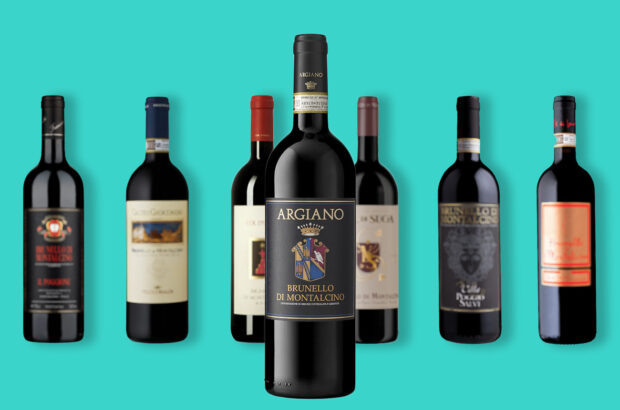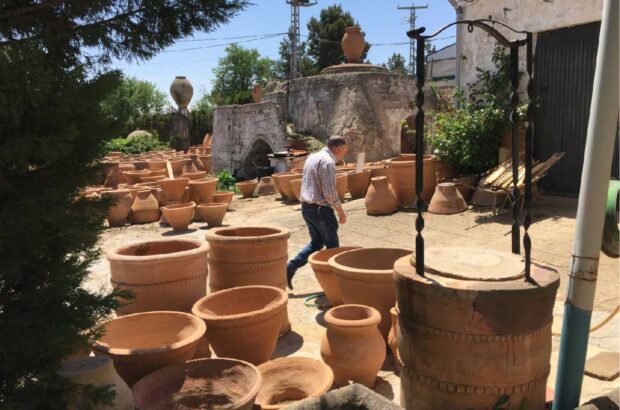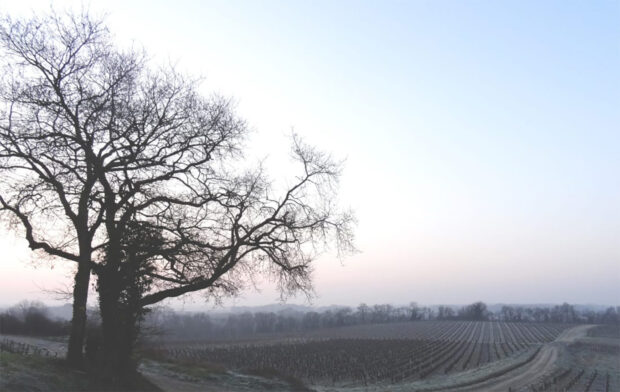- Rioja’s evolution has mostly been based on a systematic re-invention of itself in the idiom of the day.
- The past decade has seen this introverted region open up significantly and produce new styles adapted to modern tastes.
- One of the significant developments in Rioja is the change in the range and type of oak used.
- In the case of white Rioja, demand for Rioja’s most distinctive, albeit most demanding style, is on the wane.
Seen in a glass case in the cellars of La Rioja Alta: a bottle of the 1894 vintage labelled as Bodegas Modernas; a symbolic reminder that Rioja’s evolution has mostly been based on a systematic re-invention of itself in the idiom of the day. Today, a century after that wine was bottled – and after a somewhat quiet period – this process is once again vigorously underway.
Until the late 1980s, Rioja was in danger of passing its sell-by date. An ostrich-like resistance to change and unwillingness to listen to outside advice led to stagnation and a short-termism which put quantity ahead of quality. When prices went up in 1983 and again in 1988, Rioja’s competitive edge became blunted. As the New World encroached, Rioja’s export market was further jeopardised. At home, younger wine drinkers and a sophisticated press started to reject the dried out excuses masquerading as fine wines under the protection of such magnificent titles as gran reserva. However, thanks to the pioneering spirit of a handful of entrepreneurs, the past decade has seen this introverted region open up significantly and produce new styles adapted to modern tastes. The icing on the cake has been the good fortune of two fine vintages, in 1994 and 1995, giving a timely pat on Rioja’s back for its progress, and an important boost to the region’s self-confidence.
Boldness, experimentation and a willingness to take risks are key to the new styles. As Xavier Echavarri, Barón de Ley’s managing director, says: ‘The people who explore the possibilities have driven the region forward.’ Recognising the need to adapt or go the way of the dinosaurs, Artadi, Bodegas Bretón and Palacio were among the first to recognise the importance of colour and extraction. Latterly, Barón de Ley, Ijalba, Martínez-Bujanda and Remelluri have taken up the baton, bringing freshness, fruit flavour and an integrity hitherto lacking.
With a question mark raised over lengthy cask-ageing, the existing categories of quality based on ageing no longer hold water. As a result of a change in direction and style, reserva and, to a certain extent, crianza (not gran reserva), now receive pride of place in a bodega’s repertoire. Barón de Ley, Torre Muga, Roda 1, Artadi’s Viña El Pisón, Palacios Remondo’s Reserva Especial, La Rioja Alta’s Viña Alberdi and Marqués de Riscal’s Barón de Chirel are all on the list of classy modern reservas.
A trend towards longer or more careful fermentation has introduced extra colour and fruit extract. In the blends, an increase in the proportion of Tempranillo, Spain’s best red grape, has improved the quality. As in the case of Chianti, the traditional practice of adding white wine to the blend to soften the red is on the way out. Crucially, modern Rioja spends less time in oak barrels, and the proportion of new wood used has increased. Alongside fruity, unoaked styles such as Martínez-Bujanda’s Valdemar Tinto and Campo Viejo’s Albor, wines such as Cosme Palacio and Marqués de Griñón are on the increase. These youthful reds don’t qualify as crianza wines because they haven’t spent the required 12 months in oak.
One of the most significant developments in Rioja is the change in the range and type of oak used. French oak, instead of the more aggressive American variety, is increasingly employed. French oak allows more rapid development because the grain is more porous than American. Its use is contributing to the production of the required fruitier styles and at the same time adding finesse and different flavours. Not only is the fruit quality much improved but reservas and crianzas need only a year in cask (and then two years and one, respectively, in bottle). Gran reserva, on the hand, still requires the full monty of three years in cask and two in bottle. Many producers like Jean Gervais of Palacio would be happy to see the categories simplified down to two: ‘I’m inclined to think that there should be two broad categories, a basic Rioja DOC and one with specific ageing requirements.’
Remelluri, Palacio and Roda use exclusively, or almost exclusively, French oak. Other wineries, such as La Rioja Alta, remain traditional with a strong preference for American oak, while many of the more modern bodegas, such as Campillo, Muga, Lan and Olarra, like to combine the two, producing different styles matured in different types of oak or wines which spend time in both French and American barrels.
If the newer bodegas are making much of the running, the bigger, albeit less glamorous wineries, such as El Coto, Paternina, Olarra and Campo Viejo are also cleaning up their act. It’s out with the old cement tanks and in with pneumatic presses and temperature controlled stainless steel, together with up-to-date ageing facilities for both barrels and bottles. Even the most traditional wineries, Marqués de Murrieta, La Rioja Alta and López de Heredia are bringing themselves, in Riojan terms at least, up to date.
In the case of white Rioja, demand for Rioja’s most distinctive, albeit most demanding style, the traditional oak-aged white from the likes of López de Heredia and Marqués de Murrieta, is on the wane. Here too, the modern trend is to use small new oak barrels of both French and American oak in which to ferment the workhorse Viura grape. Unlike Rueda, the region hasn’t yet had the courage to allow premium French varieties, although a handful of Chardonnay, Viognier and Roussanne vines have been planted experimentally. More recently, stainless steel fermentation has given white Rioja a youthfully fresh and fruity string to its bow, but as yet the results are often wide of the mark.
Much of the excellent work on fruit quality improvement goes on, almost invisibly, in the vineyard itself. Traditionally grown ‘en vaso’ (dense, unirrigated bush vines), the introduction of cordon trellising is helping to reduce rot by optimising sunlight and ventilation. Great strides have also been made in the health and quality of the grapes at harvest, and the point of reception into the winery. Bodegas are also more clued up on the need for giving incentives to growers for strict pruning to limit yields and obtain consistent ripening. Picking at optimum maturity and selection and quality grading of grapes in the vineyard is another big leap forward.
As evidence of a renewed emphasis on attention to good vineyard management, a growing number of new wineries now claim self-sufficiency. Notable among them are Campillo, Roda, Ijalba and Ramírez de Ganuza, Remelluri and Marqués de Murrieta. Others are making wines from vineyards they control, notably Campo Viejo’s Viña Alcorta, Artadi’s El Pisón, Bretón’s Dominio de Conte, La Rioja Alta’s Barón de Oña, Martínez-Bujanda’s Finca Valpiedra, Luberri’s Altún, and Lan’s Viña Lanciano.
As the world of wine becomes increasingly dominated by premium French varietals, new found confidence in its own local raw material has galvanised estates such as Martínez-Bujanda, Campillo and Remelluri into concentrating efforts back into Rioja’s unique resource of local grape varieties, in particular the versatile Tempranillo (on its own or with Garnacha), Mazuelo and Graciano. Tempranillo, grown and made properly, is capable of producing wines of international standing, a perception sharpened by the excellent vintages of 1994 and 1995.
While the Cabernet Sauvignon craze has receded, its use remains controversial. Since the official five-year experiment with Cabernet Sauvignon expired last year, the wine authorities in Rioja have been reluctant to authorise it. As in Tuscany, winemakers are genuinely concerned that even a small amount of Cabernet Sauvignon might dilute Rioja’s ‘authenticity’. Many would prefer to see more of the perfumed Graciano. Such is its potential as a blending partner for Tempranillo that the re-introduction of this grape has been a small but significant step forward in quality.
However, Marqués de Riscal has grown Cabernet for more than a century and more and more wineries are following suit, albeit officially as an experimental grape. Among the best of such Riojas are Martínez-Bujanda’s 1990 Gran Reserva, Campillo’s 1990 Reserva Especial, Campo Viejo’s Viña Alcorta and Marqués de Riscal’s Barón de Chirel. Barón de Ley, which started with Cabernet Sauvignon when planting its vineyards, includes a percentage in its Reserva. Even Murrieta is soon to launch its own Cabernet-influenced red, a 1994 reserva called Dalmau.
As Rioja expands, its growers are getting fat on the proceeds. From only eight pesetas a kilo back in 1972, they received 132 pesetas last year even though 1997 was a bumper crop of only average quality. Amid the euphoria, a relaxation of the irrigation regulations has contributed to record yields of 7,500 kilos per hectare (ha). This is well over the 6,500 kilo maximum – special dispensation is needed to exceed this limit. Now that the legal ceiling has been reached on new planting in Rioja, which has some 51,000ha under vine, plans are under foot to obtain Brussels’ permission to extend the vineyard area by another 15,000ha. If the alternative means giving in to a temptation to stretch the wines and raise prices, such a solution could be another positive step forward in Rioja’s evolution.











